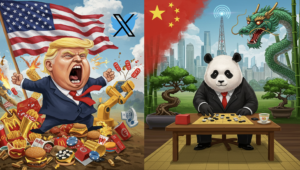The Trade War the U.S. Will Lose – Op-Ed by Wolfgang Scholtes

The Trade War the U.S. Will Lose: How Competent Governance Is China’s Ultimate Advantage
When the United States launched its trade war against China under the Trump administration, the political and media narrative was unambiguous: China would blink first. The U.S., so the argument went, held all the cards — economic, technological, moral. The tariffs, sanctions, and export restrictions were supposed to destabilize China’s industrial base, break its momentum, and force it into a new geopolitical posture on Washington’s terms.
Years later, this narrative has not just unraveled — it has reversed.
China hasn’t collapsed. It hasn’t surrendered. It hasn’t even stalled. Instead, it has adapted, reoriented, and in many sectors — surpassed. And the reason for this outcome is not just economic. It’s political. It’s systemic.
China is governed more competently than the United States. And in the long game of global competition, competent governance wins.
1. Two Systems, One Contest
The U.S. and China are not simply economic competitors. They are ideological opposites in terms of governance. The United States operates under a liberal democratic model: multi-party elections, separation of powers, checks and balances, and a free press. China, on the other hand, operates under a meritocratic, centralized, one-party model with strong institutional continuity, long-term planning, and a unified national vision.
To many in the West, the Chinese model is dismissed outright as authoritarian, illegitimate, or unsustainable. But reality tells a different story. While U.S. governance has become increasingly gridlocked, reactionary, and prone to short-termism, China’s system has shown itself to be decisive, disciplined, and strategically coherent.
Where the U.S. Congress shuts down over budget squabbles, China builds 38,000 kilometers of high-speed rail. Where U.S. politics shift with each election cycle, China pursues 30-year development plans with continuity. Where U.S. policy is shaped by lobbyists and partisan warfare, China mobilizes resources around national goals — be it AI, green tech, or semiconductors.
This isn’t about which system is “freer.” It’s about which system works.
2. Trade War Tactics: Fire and Fury vs. Strategy and Substitution
The Trump administration’s trade war was rooted in a misunderstanding of how China works. U.S. officials believed that tariffs would trigger economic panic in China, fracture supply chains, and erode domestic support for the Party. Instead, they triggered resilience.
China responded with strategic substitution: localizing its supply chains, investing heavily in self-sufficiency, and diversifying its trade partners. It accelerated tech investment, increased trade with ASEAN, the Middle East, Africa, and Latin America, and deepened its influence through the Belt and Road Initiative.
While the U.S. launched trade barriers, China launched infrastructure. While Washington threatened decoupling, Beijing built new bridges — figuratively and literally.
Today, China is a dominant force in global electric vehicle exports, leads in solar panel and battery production, and continues to climb the value chain in industries where it was once dependent.
The U.S., meanwhile, has struggled to bring manufacturing back home. Supply chain disruptions persist. Inflation remains volatile. Tariffs have hurt American farmers and consumers more than Chinese factories. And no coherent industrial strategy has emerged to replace global reliance on Chinese production.
3. Performance vs. Politics
The root of this imbalance lies in how each system defines legitimacy.
In the U.S., legitimacy is tied to procedure — elections, media narratives, and public opinion polls. In China, legitimacy is tied to performance — competence, delivery, and national outcomes.
This difference is critical. In the U.S., political leaders are incentivized to win the next election, often by appealing to emotion or polarization. In China, political leaders rise through a system of internal evaluation, party discipline, and administrative effectiveness — and are tasked with delivering real results over the long term.
China’s leadership does not need to campaign. It needs to govern — and be held accountable internally for doing so.
This has allowed China to:
– Maintain political continuity over decades
– Execute national priorities with consistency
– Adjust rapidly in response to crises (e.g., COVID-19, global trade shifts)
– Invest in infrastructure, education, and industrial upgrading at a scale unmatched by the West
And it’s why, despite all predictions, China has not only weathered the trade war — it has gained from it.
4. The Strategic Blind Spot of the West
The U.S. continues to frame the China challenge as a test of strength — assuming that more tariffs, more restrictions, or more alliances will ultimately pressure China into submission. But this ignores the deeper issue: the U.S. is trying to outcompete a country with a fundamentally more focused and better-organized state.
While America argues about debt ceilings, gun laws, and cultural issues, China builds ports, trains engineers, and negotiates trade pacts. While the West worries about TikTok, China is reshaping the Global South.
The trade war didn’t expose China’s weakness. It exposed the West’s underestimation of China’s systemic strength.
Conclusion: The Power of Competence
The true battleground of the 21st century is not ideology. It is capability. And capability is shaped not just by resources — but by how a nation organizes, governs, and mobilizes itself.
The U.S. started a trade war it thought it would win. But China, backed by a civilizational approach to governance and a population that measures legitimacy by results, is playing the long game — with patience, precision, and purpose.
If competent governance is the ultimate advantage, then the winner of this war is already clear.
Illustration: Imagen3 and Kathy